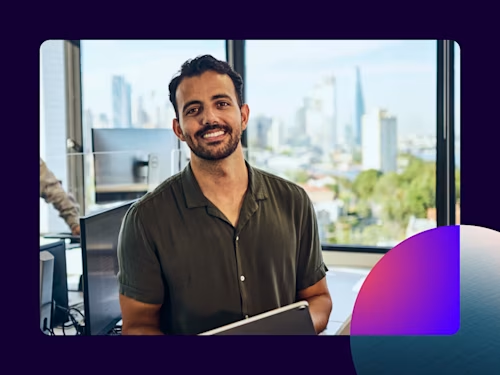
On your marks: How software companies InfoTrack and LAB Group get out in front with smart integrations
In this Q&A with LAB Group’s Nick Boudrie and InfoTrack’s John Ahern, learn about how the right integrations can help chart a new course for software companies.

Docusign recently hosted an event in our Sydney office for software companies interested in integrating Docusign into their own solutions. A highlight of the session was a Q&A with Nick Boudrie, Co-founder and CEO of LAB Group, and John Ahern, Global Head of Property at InfoTrack — who joined Docusign’s Taryn Mclaughlin onstage to discuss trends, insights and their own experiences in integrating Docusign.
Here’s a recap of their lively discussion, edited for brevity.
Q. With technology always evolving and changing in response to new market demands, businesses are forced to keep evolving, too. What are some of the big trends you’ve seen?
John: Looking back to 2016, when we started working with Docusign, the big trend in the legal industry was the digitisation of contracts for the sale of land. The idea was to free up the hours of time lawyers and conveyancers would spend collating, completing, printing and scanning contracts. But there was one problem — real estate agents wouldn’t get on the ‘electronic bus’. So, back then, our adoption of Docusign was aimed at keeping the workflow electronic from end to end.
Today, the number one trend is AI. We’ve got six AI solutions in the market already, using it to read and interpret documentation, pull data from multiple sources, and make suggestions to our clients on what they should do next. With security and compliance built in, it effectively removes the administrative burden.
To be clear, we don’t believe that AI will ever replace lawyers. An AI chatbot will never stand in court in front of a judge instead of a lawyer. But it will reduce the administrative burden, just like our electronic contract workflow did.
Nick: There’s a big focus on personally identifiable information (PII) at the moment. Realising the inherent risks around storing personal information, organisations want the ability to hold onto PII for as little time as possible before discarding it. The more manual handling of documents, the less control you have over PII — which is driving the trend towards more digitisation.
Another big trend impacting the software industry is around cost efficiencies. We’re seeing a lot of cost cutting, with businesses looking for ways to optimise processes and do more with less. They’re asking, ‘How can we use what we’ve already got? How can we get more bang for our buck in the systems we’re already paying for?’ And it’s why people are scrambling to turn on integrations.
Q. A huge number of companies are moving away from siloed software platforms and towards fully-integrated software solutions. How do you use the partner API ecosystem to give your customers more streamlined and centralised experiences?
Nick: Our platform is like a hub that stitches together a lot of different third party services, micro-services and platforms. There are IP checks, VPN checks, electronic identity verification and biometrics. There are corporate data extracts, drilling into different shareholders and identifying beneficial owners. There are downstream and upstream systems that we need to coordinate with and send data to.
All these spokes give us such a cool way to do business. And our key service proposition is that we have knowledge of those platforms and services. We know what to orchestrate or integrate to meet a particular business need; we know how to bring best-of-breed service providers to our customers in a way that’s meaningful to them.
John: Like LAB Group, InfoTrack leans heavily on integrations. We’re also an information broker — with 4,500 different products in our platform. But the thing is, to make our platform work for lawyers, we have to bring it into the case management systems they already use. And we have to do it in an exceptional, frictionless way.
So what we need to do is embed new technologies in their world — so they can go from one task to another in one click, with no login screens. It all needs to be automated and transparent, while delivering efficiency gains to the lawyers.
Q. What drove you to integrate Docusign via the ISV Embed Program?
John: The number one reason we chose Docusign was because we could just hit the APIs to provide electronic signing in the world they already operate in. The second reason? Lawyers only ever use the best. Lawyers and their clients want to see the Docusign logo — it’s something they trust.
With our choice made, two very cool things happened. First, we engaged Docusign very quickly — we showed them our proposed signing workflow for an electronic contract and quickly got to work on a proof of concept using Docusign APIs. Then, Docusign helped us go out to a few law firms and talk to them about what they could and couldn’t do with electronic signatures.
Nick: When we implement into a financial services organisation, we handle a lot of the application data — that is, customers actually applying for a product or service. When their application is processed, it’s a bit of a black box as to what happens next around manual processes that need to happen before approval. For example, a limited power of attorney may need signing, or an advisor fee disclosure needs to be witnessed.
Recently, we won a new customer. It had a limited power of attorney to open accounts on clients’ behalf which needed to be witnessed and signed by multiple parties. This tried-and-tested, legally binding document was sitting in Docusign — and it was this use case that drove the integration for us.
Now that we’re plugged into Docusign, we can essentially reuse that integration adapter and turn around integrations a lot quicker for particular scenarios. We’re already speaking to another major financial institution that needs a fee disclosure using Docusign — and we can easily show how we bring optimised elements of control and segregation of personal information to the table for their particular use case.
Q. When it comes to your partnership with Docusign, what are you most excited about?
Nick: We’re expanding overseas in the major asset management centers, where they do a lot of institutional onboarding. In these cases, when people sign a document, you don’t really know what the workflow impact is on downstream processes. I’m excited about the impact that Docusign could have here.
For example, we’re talking to a business in Luxembourg about a solution that will hopefully roll out to about 150 asset managers. It’s around authorised signatory letters, and the ability to track who’s authorised to do things like place trades on behalf of an institution. Between LAB Group and Docusign, we can tie a particular signatory back to an action to help show whether a person is actually authorised to make a trade. We’re unlocking all these processes linked to both the metadata and signatories of a contract — and it’s getting a lot of people in Europe quite excited as well.
Q. When it comes to the implementation of software vendors, what are your tips and advice?
John: The first thing we do when we assess a vendor is to see if they fit our commercial model. We also need to make sure they tick the boxes on security and compliance, and scale. But the most important thing? When you hit a roadblock or need help, you’ve got someone to call. Relationships are key — if you don’t have those technical relationships, you can’t build tech at the speed today’s users demand.
Nick: As we’ve grown the consulting side of our business, we’ve needed to get really good at stitching together vendors and orchestrating them. We need to get vendors working together in a coordinated way. And we need to look beyond the APIs and the integration, to ask, ‘What happens next? Where do documents get stored? Or, what happens if things fail?’
Indeed, I think this is one of the biggest challenges right now. We’re seeing transformation programs fail — programs that have been running for over seven years, and which have burnt a lot of money. These organisations have tried the ‘single vendor’ approach, but the market is actually moving more towards specialisation and more holistic, API-driven solutions.
Want to know more about adding Docusign to your software suite?
To find out more about integrating Docusign into your software, please reference ‘ISV Partnership’ when you get in touch.
Docusign IAM is the agreement platform your business needs


